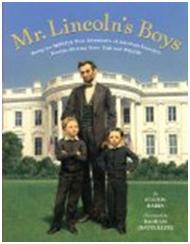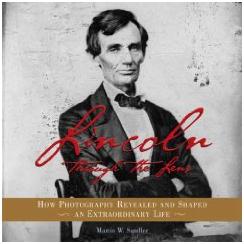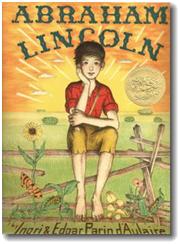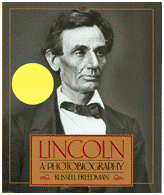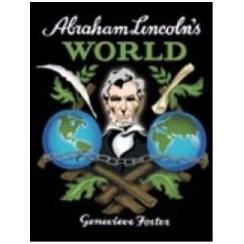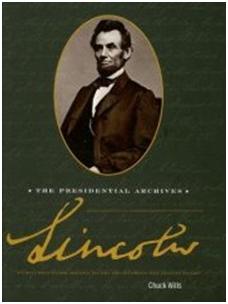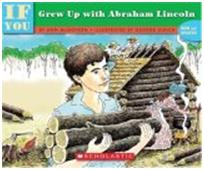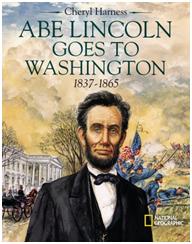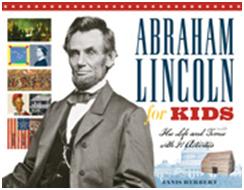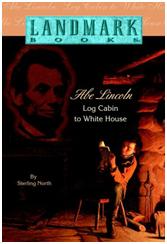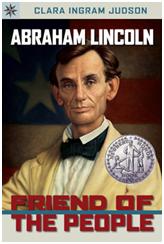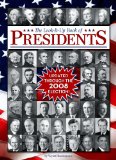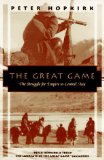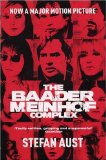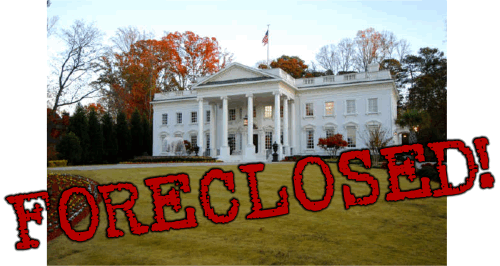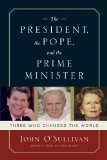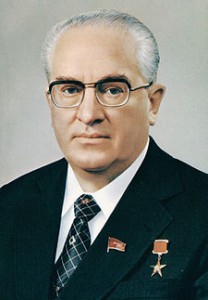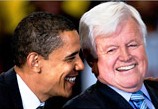Abraham Lincoln was born on February 12, 1809, just a few weeks before Thomas Jefferson finished his second term as President. (Before the Constitution was amended in 1933, newly elected presidents were not sworn in until March 4).
2009 then is the 200th anniversary of his birth. As you might suspect this has led to the publishing of a number of new children’s books on Lincoln. Here are seven books, published in 2008, that I think are the cream of the crop, along with a number of Lincoln resources published in prior years.
|
Mr. Lincoln’s Boys |
Mr. Lincoln’s Boys: Being the MOSTLY True Adventures of Abraham Lincoln’s Trouble-Making Sons, TAD and Willie by Staton Rabin, illustrated by Bagram Ibatoulline There are several reasons why this is an outstanding children’s book on Lincoln. The illustrations are fascinating in their detailed depiction of the White House in the 1860s. Ibatoulline continues to be one of the finest of current illustrators. The text gives us the boys’ view of life in the White House, with about half the pages devoted to recounting the boys’ appeal to the president for a pardon for their toy soldier “Jack” whom they had caught sleeping while on guard duty. The incident is well-documented in several Lincoln biographies and provides insight into Lincoln’s character. Text is 2nd-3rd grade level, but younger students will much enjoy hearing the story read. Mr. Lincoln’s Boys is a hardback, 40 pages, and sells for $16.99 |
|
Abe’s Honest Words |
Abe’s Honest Words: The Life of Abraham Lincoln by Doreen Rappaport, illustrated by Kadir Nelson Rappaport retells the story of Lincoln’s life from boyhood to presidency in short, evocative sentences – readable by early to mid-elementary school students, but carrying a great deal of depth. An example:
Each 2-page spread has a beautiful illustration, some short, poetic text by Rappaport, and a quote by Lincoln himself. After 10 pages devoted to the young Lincoln, the text and pictures show his early political career in Illinois, and then in 18 pages cover his presidency. There is a striking painting of the front steps on the capitol on inauguration day in March of 1865, with a ray of sunlight breaking through winter clouds Text is 2nd-5th grade in reading level. Abe’s Honest Words is a hardback, 48 pages, and sells for $16.99 |
|
Lincoln in His Own Words |
Lincoln In His Own Words edited by Milton Meltzer, illustrated by Stephen Alcorn For older students who want to study Lincoln, I highly recommend this volume. Primary source material is the only way to truly understand any historical figure. Meltzer has not just edited/selected from Lincoln’s writing. He includes a narrative and introduction to each piece that sets it in context and provides invaluable help to the reader in understanding Lincoln’s views and the historical context that frame his thoughts. Text is middle school to high school and adult. This is a paperback release of the hardback from 1993 Lincoln in His Own Words is a paperback, 226 pages, and sells for $9.99 |
|
Lincoln through the Lens |
Lincoln through the Lens: How Photography Revealed and Shaped an Extraordinary Life by Martin W. Sandler Photography was invented during Lincoln’s lifetime. While he was president, he became the most photographed person on the planet – most of them by Matthew Brady and his assistants. Sandler has selected the most historically significant, including not a few which were not discovered in the archives until the 1950s and later. There is an amazing shot of the 2nd inauguration in which Booth and five of his conspirators have been identified. Text is junior high and up Lincoln through the Lens is a hardback, 97 pages and sells for $19.99 |
|
The Lincolns: |
The Lincolns: A Scrapbook Look at Abraham and Mary by Candace Fleming This is a fabulous wealth of primary sources. Not just photographs of Lincoln, but newspaper accounts, engravings, cartoons, letters, book covers, and short narrative descriptions of each one. Includes the latest Lincoln discoveries (yes, they’re still finding things!) including letters between Mary and her son Robert which were only discovered in 2006. Mary’s life from 1865 to her death in 1882 is a tragic tale. Their second son, Eddie had died, age four in 1850. Willie had died while they were in the White House. Tad died in 1871 at the age of 18. Of their four sons, only Robert survived. And he and Mary became estranged after his marriage in 1869.
The focus of the scrapbook is a personal history of the Lincolns, though it necessarily includes references to the political and military events of the day. The author spent five years researching, collecting items, and writing the book. Not a continuous narrative, but as the title declares, a scrapbook of fascinating, original items. The Lincolns: A Scrapbook is a hardback, 181 pages and sells for $24.99 |
|
Abraham Lincoln Comes Home |
Abraham Lincoln Comes Home by Robert Burleigh, paintings by Wendell Minor This children’s book tells the story of the Lincoln funeral train, from the point of view of a young boy and his father who ride out in the middle of the night to join thousands of others as they gathered by the tracks to pay their final respects. There are two pages of historical notes about the funeral train, which traveled 1600 miles over 13 days and made stops in 12 cities. In New York, over a million people turned out to watch the funeral procession which included one hundred thousand Union soldiers. The text is 1st-3rd grade in reading level. Abraham Lincoln Comes Home is a hardback, 40 pages, and sells for $16.95 |
|
Lincoln Shot: A President’s Life Remembered |
Lincoln Shot: A President’s Life Remembered chief writer: Barry Denenberg, artist: Christopher Bing An oversized book designed as a special newspaper edition that might have been written on the day of his assassination, and in the days immediately following. Begins with the events of the assassination and then covers Lincoln’s life with sections on Boyhood, Youth, Politician, Candidate, and then 20 pages devoted to the Civil War Years. The layout and style give the information an immediacy that will appeal to many young readers. Oversized format, 18″ high by 12″ wide helps convey the feel of an illustrated 1860s newspaper. Reading level is middle school and up. Lincoln Shot is a hardback, 40 pages, and sells for $24.95 |
Not all the good books on Lincoln are new, of course. There are three classics that I would highly recommend.
|
Abraham Lincoln |
Abraham Lincoln by Ingri & Edgar Parin d’Aulaire When this book was created in 1939, America was at a crossroads. Hitler’s armies had gobbled up Czechoslovakia and conquered Poland in Septermber. As European immigrants the d’Aulaires felt keenly the importance of standing against injustice, and saw in Lincoln the archetypal American hero. It was this spirit they hoped to exemplify in their biography of young Abe as he grew into manhood against the backdrop of the wilderness of Kentucky, the deep woods of Indiana, and the prairies of Illinois. Camping for weeks in Lincoln country, the d’Aulaires imbibed the spirit of the man Lincoln as well as his humor and good will. From his days as a clerk, teaching himself law reading Blackstone, practicing law in Springfield, running unsuccessfully for office, debating Stephen Douglas over the issue of slavery, and ultimately becoming President of the United States, the d’Aulaires have written and beautifully illustrated the life of one of America’s most remarkable citizens. This book was awarded the Caldecott Medal in 1940. The text is middle school and up. Abraham Lincoln is a paperback, 60 pages and sells for $13.95 |
|
Lincoln: A Photobiography |
Lincoln: A Photobiography by Russell Freedman In 1988, Freedman won the Newbery medal for this remarkable book. It tells the story of Abraham Lincoln with photographs and prints, providing a vivid look at the life and times of one of the nation’s great leaders. Lincoln: A Photobiography is a paperback, 160 pages, and sells for $9.95 |
|
Abraham Lincoln’s World |
Abraham Lincoln’s World by Genevieve Foster An interesting look at the man and the world in which he lived. Britain’s enormous growth and emergence as a democracy, Germany’s unification under Bismarck, the freeing of the Russian serfs, the opening of Japan to foreign trade, and many other events are outlined. Foster’s engaging text is interlaced with pictures, maps, and time lines. She succeeds in painting a plethora of figures as real people, while putting their actions in a broad world-wide context. Reading level is middle school and up. Originally published in 1944 Abraham Lincoln’s World is a paperback, 360 pages, and sells for $17.95 |
There are also these excellent resources on Lincoln, published in previous years:
|
Lincoln: The Presidential Archives |
Lincoln: The Presidential Archives by Chuck Wills Published in September of 2007. Chuck Wills is an accomplished author and he does an excellent job outlining Lincoln’s life and political career in nine chapters. The text is interspersed with hundreds of photographs and shots of newspaper headlines and front pages. What really sets this book apart is the inclusion of facsimile reproductions of original documents. About a dozen are included, each on a tinted separate heavy-stock sheet slipped into a translucent pocket at the appropriate place in the books narrative. With the chapter discussing Lincoln’s boyhood and education, there is a reproduction of a page from his “sum book.” In the chapter on his marriage and young family, there is a reproduction of his marriage license to Mary Todd. In each case, holding an original document (even if it is only a well-crafted facsimile) makes the historical account richer, nearer, more tangible and provokes a more visceral, emotional response. It makes Lincoln much more real, much less abstract. The text is written on an adult level (though certainly not too advanced for high school students), and many students will need some help in absorbing and understanding the historical documents, but I can’t think of a better way to introduce students to the raw materials of history and historical research. For anyone with a historical sense of who Lincoln was (and the text and photographs will give it to you), seeing a flyer for a play at Ford’s Theater on April 14, 1865 and then seeing the “wanted” poster issued in the manhunt for Lincoln’s assassins produces a profound effect. For anyone with an interest in Lincoln, I highly recommend this book – especially if your students have an interest in understanding how historians conduct their research. Note: 2009 will be the bicentennial of Lincoln’s birth. I know it’s a cliché to study Lincoln around President’s Day, but 2009 will be a special year. Here’s a list of the historical, facsimile documents included in the book:
Lincoln: The Presidential Archives is a hardback, 159 pages and sells for $40.00 |
|
If You Grew Up with Abraham Lincoln |
If You Grew Up With Abraham Lincoln by Ann McGovern “If you grew up with Abraham Lincoln, what kind of house would you live in? How would you travel? What would you do for fun?” These – and 25 other questions children might ask about life in Lincoln’s time – are answered in this information-packed book for young readers. The author shows boys and girls what it would be like to live in the same places that Lincoln lived – as a boy in Kentucky and Indiana, as a young man in the prairie town of New Salem, Illinois, and later in the city of Springfield, Illinois. A picture appendix shows what great changes occurred from the time Lincoln was a boy to the time he was President in Washington D.C. If You Grew Up with Abraham Lincoln is a paperback, 32 pages and sells for $5.99 |
|
Young Abe Lincoln |
Young Abe Lincoln: The Frontier Days, 1809-1837 by Cheryl Harness Details about the early life of Abraham Lincoln unfold from eye-catching artwork and lively text in this biography in which readers discover a self-taught man of character and compassion growing up on the frontier in the early 1800s. Full-color illustrations & maps. Young Abe Lincoln is a paperback, 32 pages, and sells for $7.95 |
|
Abe Lincoln Goes to Washington |
Abe Lincoln Goes to Washington, 1837-1865 by Cheryl Harness This sequel to “Abe Lincoln: The Frontier Days, 1809-1837” follows Lincoln’s life from the age of 28, when he arrives in Springfield, Illinois, ready to take up his post in the state legislature, to his assassination in 1865. Includes six maps researched by the National Geographic Society. Full-color illustrations. Abe Lincoln Goes to Washington is a paperback, 32 pages, and sells for $7.95 |
|
Abraham Lincoln for Kids |
Abraham Lincoln for Kids: His Life and Times with 21 Activities by Janis Herbert Providing a fresh perspective on one of the most beloved presidents of all time, this illuminating activity book tells the rich story of Abraham Lincoln’s life and details the events of his era. Highlighting Lincoln’s warm, generous spirit and impressive intellect, the guide teaches children about his fascinating life story, his struggles at the onset of the Civil War, and his relevance in today’s world. Activities include delivering a speech, holding a debate, drawing political cartoons, and making a stovepipe hat or miniature Mississippi River flatboat. Lively sidebars, abundant photographs and illustrations, and fun projects help to kick the dust off old Honest Abe. Selections from some of Lincoln’s most famous speeches and documents, as well as a resource section of websites to explore and sites to visit, are also included, making this a comprehensive Lincoln biography for young readers. Abraham Lincoln for Kids is a paperback, 160 pages and sells for $14.95 |
|
Abe Lincoln: Log Cabin to White House (Landmark) |
Abe Lincoln: Log Cabin to White House (Landmark Book) by Sterling North Yes, that’s the same Sterling North who wrote the classic children’s book, Rascal! He was commissioned by Random House to write biographies of George Washington and Abe Lincoln for the Landmark Books in the 1950s. This is an excellent first biography of Lincoln for upper elementary/jr high The Landmark Abe Lincoln is a paperback, 160 pages, and sells for $5.99 |
|
Abraham Lincoln: |
Abraham Lincoln: Friend of the People by Clara Ingram Judson This Newbery Honor Book from 1940 — from a three-time Newbery Honor author — paints an indelible portrait of the prairie president. Clara Ingram Judson presents Lincoln in all his gauntness, gawkiness, and greatness: a backwoods boy who became President and saved the Union. Judson’s careful reading is enlivened by her visits to his home and vivid descriptions of the Lincoln family’s pioneer life. She reveals the unforgettable story from his boyhood and days as a shopkeeper and lawyer, to Lincoln’s first elected offices and his election as president, the Civil War, and assassination. Abraham Lincoln: Friend of the People is a paperback, 195 pages, and sells for $6.95 |
Any of the books reviewed here can be ordered from Greenleaf Press just by clicking on the image of the book cover or the linked title.
